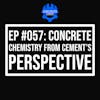EP #065: Reclaiming Fly Ash: A Concrete Solution
Ever wondered how reclaimed fly ash could revolutionize the concrete industry?
Tune into this episode of the Concrete Logic podcast where we’re shaking things up with Pete Paone. We’re diving deep into the world of reclaimed fly ash, a byproduct that’s about to make a big splash in the concrete world.
If you’re curious about the future of concrete and reclaimed fly ash, this is one episode you won’t want to miss! ***
Did you learn something from this episode? If so, please consider donating to the show to help us continue to provide high-quality content for the concrete industry.
Donate here: https://www.concretelogicpodcast.com/support/
***
Episode References
Guest: Pete Paone | ZAP Engineering & Construction Services | paonep@zapecs.com
Guest Website: https://www.zapecs.com/
Producers: Jodi Tandett, Olivia Stocker, Ron Macken, Thomas Ginther
Donate & Become a Producer: https://www.concretelogicpodcast.com/support/
Music: Mike Dunton | https://www.mikeduntonmusic.com | mikeduntonmusic@gmail.com | Instagram @Mike_Dunton
Host: Seth Tandett, seth@concretelogicpodcast.com
Host LinkedIn: https://www.linkedin.com/in/seth-tandett/
Website: https://www.concretelogicpodcast.com/
LinkedIn: https://www.linkedin.com/company/concrete-logic-podcast
Seth: [00:00:00] And welcome to another episode of the Concrete Logic podcast. And today we got Pete Paone. On your last episode, we got a lot of accolades; said we got to have Pete back. So thanks for coming back on the show, Pete.
Pete Paone: No problem, Seth.
Glad to be back.
Seth: So Pete's the guy that opened my eyes to how cement is made and why shouldn't always badmouth the cement producers. he's changed my mind. I appreciate that, Pete. And we're going to get into it here in a minute. Just want to again, let you all know that you can support this show in several different ways.
First is please share it with someone that you think that we'll get something out of the podcast that's appreciated. You can forward it through whatever podcast platform you use. We’re active on LinkedIn. you can also donate to the show just wanted to give a quick shout out to the folks that recently donated to this show because of them, they are helping this podcast,
[00:01:00] Recently, Thomas Ginther donated to the show, appreciate it Thomas, Ron Mackin, Ron was on the podcast a long time ago Ron, I hope your Concrete House is going well Olivia Stocker, she's a contributor every month, and Jody Tandett I appreciate everybody that donated to the show.
Oh one more. Sorry. Patrick Bridgman looks like he's from New Zealand. Appreciate your donation as well. Like I said you can either share the podcast or if you want, if you get something out of our discussion today with Pete or any other previous and you say, whatever tidbit that I learned today is worth a dollar, $5, whatever. You can go to our website in the upper right-hand corner.
There's a donate button. You just [00:02:00] click on that and then you can put in as much as you want. On there and every little bit is appreciated. So thank you.
Pete, I brought you on today because I was looking for someone that could talk about reclaimed fly ash. My favorite power company. I guess I don't really have a choice here in Virginia is Dominion Energy and they recently took on a project where they are reclaiming out of there, I guess these are called ash ponds, right?
They're removing 15,000,000 cubic yards of ash. They had to get the state to buy in. There's permits involved. There's people were concerned about the amount of trucks, coming out of this place and because 15,000,000 cubic yards is a lot.
But now my understanding is this reclaimed fly ash is going to be used in concrete to offset our cement use. [00:03:00] So it's. Since we're not using coal plants as much as we used to, my, my simple brain, Pete says they used to just get fly ash fresh, so they fell down and they collected it and then sold it to the ready mix guys and the ready mix guys offset the cement use with the fly ash and now this.
Reclaimed fly ash is this is coal ash that's been sitting in a pond for a while and they're mucking it out. And then I was like how are they going to get that stuff so that we can use it like we've been using the original fly ash. that's what I'm hoping you can help us out with today, Pete.
Pete Paone: Sure. And hopefully the answer is they're going to get it carefully, so they get the right type of fly ash for what you guys need it for. But, yeah, it's, an interesting, it's a whole little ecosystem of businesses, the whole ash handling area around power plants. [00:04:00] For your listeners, when you're, firing coal for a utility you're firing coal to boil steam, boil water, make steam turn a turbine, make power.
There's two types of ashes that you normally see from those facilities. You hear about fly ash, and you'll hear about bottom ash. So bottom ash is all the ash that falls out of the boiler comes out the bottom of the boiler is like a larger slaggy particle, right? The fly ash is all the really ultra fine leftover ash from the coal that comes out of the boiler, flies out with the exhaust gases.
and has to get captured somewhere. So in the old days you'd be allowed to just emit that out the chimney and those days have been long gone. So you have to have some type of a collection unit to get the ash. So there's a couple of different ways to do that. You can use a bag house. [00:05:00] So a big, giant box that's filled with the, they look like long vacuum cleaner bags.
And you, collect all the ash on those bags and every now and then you pulse them to get the ash off of them. One of the older technologies out there is an electrostatic precipitator or an EP or an ESP. So in those, you have these collecting plates and you try and get a static charge on the ash, and then the ash gets sucked over to these collecting plates.
And then every now and then you shake the plate a little bit and the ash slides off the plate and gets collected at the bottom. And then there's there, there's a whole bunch of these, different. Whether it's a bag house or an EP or some plants will use a venturi scrubber where they spray water in and they get it into a slurry form to begin with, regardless of what form it is, a lot of the plants would transport all of that ash out to a big pond.
So if you had a bag [00:06:00] house, you had an EP, you'd slurry, you'd add water to that dust and then you'd let it flow down a long pipeline into a big area. And normally what you'd have is a big containment area that was big, like a big earthen dam. So you would have it flow out there, and you'd normally have the water recycled back to the plant.
So you have this pond, all the ash would settle out in the pond, and then you'd recycle the water back to the plant so that you could use it to transport more ash down. That way you don't have to treat the water or do anything like that. You just use it as a closed loop and recycle it. My interest got piqued by this back in 2008.
There was a big spill down in Tennessee. Tennessee Valley had a plant down near Kingston. And they had a big ash pond. And after a month of heavy rain, the big dike, the big earthen dam that was holding back all the ash decided to let loose. And [00:07:00] basically inundated community, all this ash came flowing down the hillside through the valley wiped out a couple homes and whatnot.
And at that point there was a lot of conversation among regulators about what are we going to do because a lot of power plants had these big ash ponds around that had, like you mentioned, millions of cubic yards of this material sitting around. Now, at the same time, all these plants had been ponding ash, as you mentioned, a lot of cement and a lot of ready-mix folks figured out that you could start using the ash as a, an additive in cement and, that's been known.
For a long time, going back to the 1930s and 1940s, there were studies published about using ash. The important thing is that ash, the ash is a byproduct. It's not a mined material normally. It's the leftover waste from the power plant. And it's, dependent on how the power plant is burning [00:08:00] and what the source of the coal is.
So there's different grades of coal. They all have different amounts of leftover stuff. When you burn them, anyone who's got like a coal, furnace in their house they're pretty popular here in Pennsylvania. You know that you have to clean out the ash from the furnace every now and then it's all the leftover stuff that doesn't burn and the quality of the ash varies.
because you get different seams of coal with different amounts of ash content. One time I visited a power plant here in Pennsylvania that burned culm, C U L M, culm. Culm is like the stuff that's on the edge of the coal seam. So it's like a mixture of coal with a lot of shale and other stuff. So the ash content of a culm might be 50, 60, 70 percent of what you're burning comes out as ash. If you're burning anthracite, you tend to have a low ash. If you're burning bituminous, you might have 15 or [00:09:00] 20 percent ash. So the amount of ash really varies and the amount of ash that comes out of a plant on a daily basis might vary with what the coal supplier was, doing that day where they, were pulling it out from.
A lot of plants have used ash for a while. Normally the fly ash tends to be a little bit better viewed. It tends to be finer. So it's got a lot more surface area. It's a little more reactive towards, when you're adding it into your cement or your concrete, it tends to provide a little bit more of a strength boost because it's got all this surface area that other crystals can grow off of and bond to and gain strength in your concrete.
But it really depends on the source and the day. So, that's the real big thing is it's a waste product and many suppliers have to be careful what they're pulling from. A lot of times your gradation on the ash is determined by the leftover coal content. So when the coal burns, since it's a solid particle, it takes a little bit of time to burn all the way through and you don't get a perfect [00:10:00] efficiency in that boiler.
Quite often you'll have some leftover coal residue, some leftover carbon in the ash. And. You guys in the ready-mix industry don't like to see a lot of carbon that carbon, number one it's, not really going to help your, concrete strength at all but number two, it tends to do things like eat the air entrainment additive.
So you wind up having to use more, air entrainment when you have a high carbon content in the fly ash. So there's different grades to it. And for a long time now. Cement plants, ready mix operators have started to become a little more dependent on ash. And now we're seeing a lot of those coal fired utilities start to close down.
Recycling some of that ash and reutilizing it and mining it out is becoming a little bit more popular as a means of trying to make up for that shortfall in material that other people have become dependent on. So I know that's a long-winded answer, Seth, but I hope that goes a little way towards explaining where we got to where we're at. [00:11:00]
Seth: Yeah, that was awesome. Thank you. The one thing I was going to ask, and I don't know if this is appropriate, at this point, or if you were going to get into this, so there's the different types of fly ash. When they put that fly ash in these ponds do they separate them by the different fly ash or do they just, everything goes into the pond?
Pete Paone: Either or it all depends on the plant. A lot of the plants that I deal with they'll take the fly ash down and they'll do something different with the bottom ash. But there are plants that, that kind of combine both 1 of the, I'll say one of the sneaky little problems that I got into 15 years ago when trying to first start looking at how do we reclaim this stuff.
You have a long pipeline, right? This stuff that comes down into the pond is delivered through a long pipe and it's a little chunky. It's, not meant to be 100 percent water with a little bit of tiny ash in it. If you look at it, it [00:12:00] looks like a chocolate milk or it looks like a thick, sometimes almost like a pudding coming out the end of the pipe.
So the water, tends to come out the top, the solid settle out and the water floats the top and then you take the water back every now and then if the pipe was sitting in the middle of the pond, you'd have to move the pipe end, right? So you'd have the pipe out in the middle of the pond, because if you just put it in one place, you just wind up with this, gradual slope coming up and eventually you.
Over, overtake the end of the pipe and you can't get anything through it. So a lot of times you got to go out and you got to move the end of the pipe. The problem with that is that this stuff, this ash that you've put in the pond is still 20 or 30 percent moist. It's like walking through pudding you can't really step on it.
You can't do anything like that. So a lot of workers at the plant go out and throw down gravel or throw [00:13:00] something so that they have something solid to walk across. And then they move the pipe to the next spot, so it doesn't get filled up. Now 40 years later, as you're trying to reclaim the ash, now you don't have to just worry about the ash that you have in the pond.
You have to worry about all that gravel. All that junk that got put in there so people could walk it's a plywood and whatnot. So trying to separate that out, separate the good ash from the junk that was put in there is a little bit of a problem as we try to get into reclaiming it.
.
Seth: I'm thinking this stuff looks like a sludge, right? It's a slurry sludge. So not only do they need to worry about that, I'm curious what they do with the water too, as well.
Pete Paone: So, a lot of the times you'll have a pump, and you pump the water back over to the plant so you can loop it around.
So you get some that evaporates off, you get some of it that, [00:14:00] that winds up looping back to the plant so you can reuse it.
Seth: Yeah, but when they, start to go through this reclaimed fly ash process where they're digging it all out, what are they doing with the water?
Pete Paone: So hopefully over time, some of that surface moisture is dried out.
So it's no longer 20 or 30 percent solids. Now it's 20 or 30 percent liquid and the rest of it's all solid. The material becomes incredibly nasty to handle. You don't want to walk on it. You don't want to. It's, very, especially the ash is very, fine. So again it's like walking through pudding.
I wouldn't recommend going out there just in boots and a pair of jeans, you probably want some waiters cause you're going to sink down to your ankle or your knee. One of the biggest challenges we run into in the reclamation side of it is drying it right. You guys don't want to see it at the plant come in as a pudding at the cement [00:15:00] plant, we don't want to see it come in as a pudding.
So a lot of times what you're looking at doing is some kind of a drying step to try and get as much moisture out as possible before you do something else with it. So there are a couple companies out there that are devoted to, I'll say, rehabilitating the ash. And I won't name company names, but there’s a couple companies that are just devoted towards ash handling and devoted towards ash rehabilitation and ash management might be the best way to put it.
They'll be hired by a power plant, or they'll be hired by someone who's got a lot of this ash to basically get rid of it and manage it. A lot of the challenges is how do you, dewater it? A lot of it's very fine material. It's hard to convey. Wet and trying to get it broken down so you can dry it instead of having come out as clumpy lumpy stuff.
It's a big challenge. [00:16:00] So getting it from point A to point B and then, again, it's a waste product. So if you're excavating some part of a pond, you can see a big variation in the chemistry of the material coming out. So there's a lot of focus on, beneficiating it, right? So you guys don't want to see the carbon content.
There's companies out there that actually sell systems for separating out low carbon from high carbon fly ash, and then talk about taking the high carbon fly ash as let's say a raw material for a cement plant because they can use the ash content at the same time, they can burn off what's left over the carbon.
So maybe take that to a cement plant, use it as a raw material and then take the low carbon ash and use it directly to a ready-mix facility or use it as an additive into a cement. There are processing steps in there to try and improve it before it gets to the end user.
Seth: And [00:17:00] you're going to let us know what those are, right?
How do they do that? I'm just picturing what Dominion's doing right now. I just see an excavator kind of dipping down into this in these ponds and filling up all these dump trucks and taking it somewhere and it's like you said, it's all wet. So they got to take it somewhere to let it dry out naturally. Are they putting in a processor in a machine? What are they doing once it leaves the site?
Pete Paone: it all comes down to the ash, right? Some ashes you can lay out and try and dewater them naturally in sunlight. But big problem with that is if it's really fine as it starts to de-water and dry out, now you're gonna lose some of that ash 'cause it's gonna blow away with the wind to the neighbors probably aren't gonna like it. So that's really not a preferred method that you see too many people using. Normally there's some testing involved to see what's going to work best. So you can put it through a rotary dryer. Big long tube [00:18:00] with heat on one end, you're going to put the ash through and try and dry the moisture out.
You do have some places that try and flash dry it. So you put it, now you're trying to spray it in and you're trying to put it in this hot gas stream and basically have all the moisture evaporate as the ashes is in the air again and then collect it and take it out. So there's a couple of different approaches.
A lot of what you do with it depends on how the material handles, because if it's not going to separate well, you're probably not going to get it airborne and you're not going to get it to dry well. And on the other side, if it does start to dry out and all you do is lose all the dust out of it that's a bad thing.
So we, try you try and pick how you're going to do it based on what the material. handling characteristics are and how easy or how hard it is to dry. There's a number of people out there that try using belt filter presses. And similar machines where you try and basically squeeze the moisture out of it and keep the solids behind, all depends [00:19:00] on how easy or how hard it is to, to dewater the material.
And then from there, if you want to separate out the carbon, if it's dry, a lot of processes actually rely on static electricity. So you have some charged belts go past each other and you naturally have one carbon attract to the positive charge and you get a different level of carbon to the negative belt.
So you wind up electrostatically separating the ash between a high carbon and a low carbon. So there's a couple companies out there. In fact, there's one technology that was originally designed by a cement producer, and then they spun that off as its own company for ash handling. And that's what they do.
They do electrostatic separation and then from there again, depending on what you're going to do with it, you grind it. So you have a number of facilities that then grind the ash. And sell it off as, again, either, either material for a cement plant or, [00:20:00] as a product for a ready-mix facility.
Seth: It almost sounds like you're creating a different cement, same kind of process almost.
Pete Paone: Similar, but you're not, burning it. You're not melting the minerals and making a new kind of rock. Generally the stuff that comes out as a fly ash is like a pozzolan.
There's, a high amount of silica and Illumina and little bit of iron, normally less on the calcium side. So if you look at it it's akin to metakaolin or, like a natural pozzolan depending on the ash of the class of the ash.
Seth: Oh, it just sounds like a nasty operation.
Pete Paone: It's not the most fun, again I, started getting involved in it 15 years ago because of the Kingston spill. And at the time, I was working for F. L. Smith, and we were working on some other processes for, I'll say [00:21:00] environmental controls. So I was getting really heavily involved in mercury control from cement plants.
And one of the big things that people tend to hit out at coal ash on, is its content of other nasty compounds. So things like vanadium and selenium and mercury. Ashes got a bad name in the cement industry because when the EPA was starting to limit how much mercury you could emit from a cement plant, a lot of plants that had problems were finding that the mercury coming into the plant was coming in with the fly ash or the bottom ash.
And the reason for that is because the coal, if you think about what's, happening as you burn it. The coal millions and millions of years ago was some dead animal. It was a dead animal. It was a dead plant. Everything bio accumulates those minor compounds mercury and selenium and vanadium and all those things are just in You know all around us and we tend to take in very small quantities of [00:22:00] that well, if you think about how that coal was formed you have thousands if not millions of years of dead plants and animals all Squishing together and you're losing a lot of the moisture content that was in them.
You're getting rid of a lot of the carbon you're concentrating all the carbon and all that stuff that's in them. So what tends to happen is the coal, reflects a much more concentrated amount of some of those materials from all those living things dying off. And then once you burn it, 85 percent of what's in there is coming off.
So now you've got an even more concentrated amount of material left behind. So you wind up with a higher concentration of things like mercury and selenium and vanadium and those kinds of compounds left behind in the ash. I was involved in an effort to try and figure out a way to clean the ash so that a cement plant could still use it as a raw material.
So myself and a couple of my colleagues at the time actually tried patenting a [00:23:00] way to reclaim high mercury ash. And then drive off all the nasties and collect them and concentrate them elsewhere so they could be disposed of as a different sort of waste. So the plant could still reuse the main content of the ash without having to worry about those things affecting their emissions.
Seth: And what happened, Pete? What happened to that?
Pete Paone: I moved on. I left that company before it was ever granted. I think the other co-inventors also left. So I don't think it ever, made it through the patent office. Cause there wasn't anyone pushing for it anymore.
Seth: Is there anybody else other than the concrete industry or cement industry, that's going to use this waste product?
Pete Paone: I'm sure there are. Probably because there's so much of it. There's so much of it available and because there's, such a, demand for it in concrete, it's the primary place where people are going to sell it to [00:24:00] there were a couple of companies 10 and even five years ago that we're looking at harvesting the ash and trying to separate out some of these metals that are concentrated in there so that they could be reused.
So I know there's one or two companies out there that have looked at the content of rare earths. And they want to see if they can try and, find in a financially responsible manner, extract out those rare earths from coal ash, since there is so much of it, it's already been concentrated downward.
Seth: Do you know how much there is of these, ponds in the U. S.?
Pete Paone: Off the top of my head I, don't, but one of your other... Former guests on the show, John Kline. I know he has a pretty nice collection of that information on where those ashes are available because we've worked on one or two projects together.
Seth: Yeah, but it's a pretty big, it’s a big issue, right? These things are [00:25:00] all over the place.
Pete Paone: I'll say that the bigger issue is that there, there are more legacy ponds than active ponds. So the concern I have isn't the ones that are currently running because they're being managed, but all these plants that are shutting down there.
They're coal firing and they're either converting to natural gas or they're just shuttering the plants. There's going to be a big footprint of these legacy ponds that have to be dealt with. And it's not just utilities. There are a lot of ponds out there for other processes. Anyone who's got an aggregate facility probably has a pond on site where they wash the aggregate, and they wind up getting the fines off.
So you wind up with a lot of ponds out there that are for aggregate facilities. You have, a lot of mining operations have big tailings ponds that in the long run have to be dealt with. And one of the big things that I've been involved with the last couple years is trying to find ways to take some of those tailings and convert them [00:26:00] over to cementitious materials.
So I gave a presentation at the IEEE this past year talking about calcining clay and more appropriately, calcining some of the materials in these tailings’ ponds. as a means of trying to reclaim them so that people don't have to open new ponds. So look at it as the gold mine in their backyard and recycle that material and reuse it as opposed to having a big landfill, essentially.
Seth: Yeah. Do you know, these currently active coal or coal burning plants, are they, treating their fly ash differently than when they were using these ash ponds or are they handling things a little bit different?
Is the demand for fly ash so great that they don't even need these ash ponds or what does that look like?
Pete Paone: I think it really depends on the location. I've been to a couple of plants where, you know you, have legacy ponds that are just sitting there, [00:27:00] untapped. There are a couple of plants where you have an outside ash management company that's in there and either.
Managing all of the ash that's being produced on a daily basis, and I'm sure that they have contracts where they have to provide a certain amount of ash, and normally you'll see them excavating some of the old ponds and pits. They're not all ponds. There are some facilities that do have a dry ash that comes out and they have companies that'll come in and manage all of that so that the utility or whatever the producer is can focus on their day-to-day job.
And then the ash management firm focuses on making sure that they're dotting all their I's and crossing all their T's when it comes to environmental management and then handling all the material that's being produced.
Seth: Is there different class, classes of fly ash? Where does this fall under which class?
Pete Paone: Again it depends on the [00:28:00] on the facility. I don't think there's a good answer as far as where they all fall under it'll, come down to the facility and what their sources and where they're tapping into it.
Seth: All right. Is there anything else that we didn't cover that you wanted to cover regarding the fly ash?
Pete Paone: Just that it's, it is an active market. It's, from the cement side, there are a couple of locations where the state D.O.T. has mandated the use of ash in some circumstances. And in those facilities, the fact that we're closing down coal fired utilities is a problem. So there's a I don't want to say a mad rush.
It's certainly a little bit less chaotic than just guesswork. But there's a lot of work going into trying and finding some alternative sources of materials that could be reused. From one perspective it's, good that we're trying to green up the industry and we're trying to find new and inventive ways of reusing these materials rather than just wasting them.
But from [00:29:00] another standpoint, there's going to be a learning curve. We're probably in the, in a period of time where we're going to see a massive transformation in what we consider to be cement and concrete over the next couple of years. There's no doubt that the cement and concrete we use 20 years from now is going to be very different from the cement and concrete we're using now.
And a lot of its driven by materials like fly ash and calcined clay for which right now, I don't want to call it the wild west, but there's a lot of discovery taking place as far as what we need to do to make sure that we come up with concrete mixes that are better, sustainable and able to give us a durable long lifetime.
I think the last thing we want to see is a whole bunch of concrete structures decide that we're going to have to redo them because of failures that we made now as we're trying to do a good thing elsewhere.
Seth: Yeah. And there's going to have to be new ways of testing it to all these different [00:30:00] concretes, I think too, cause you can't test it like the original Portland cement mixes that we've been used to using.
Something's going to have to change as far as figuring this out. Cause I don't think we got enough time to wait 20, 30 years to see, oh yeah that was, the reclaimed fly ash, mix design, the calcined, clay design, and that's why that failed or is holding up or whatever.
I don't think that's going to work.
Pete Paone: Yeah. I am by no means an expert when it comes to ASTM standards it's. The other side of the business for me, I get to focus more on how am I going to adjust my mix. On the raw material side going into the plant side too, to make sure that the chemistry coming out is going to do X or Y or Z, right?
I spoke to someone from ASTM a month ago at a conference out in Utah, and one of his lamentations was performance specs. [00:31:00] Like trying to get people to look more towards performance and attaining performance characteristics as opposed to hitting certain numbers on a calcium content or an aluminum content or anything like that.
And I think that's really the way that things are headed. I don't think they're there yet, but that's the way things are headed, particularly as we're getting into this scenario of having all these, different compounds going in that are going to be very different chemically from what we're used to.
Seth: Yeah. I think we tried that performance spec before hopefully we get it right this time.
Pete Paone: I'll keep my fingers crossed for you guys on the concrete side.
Seth: Yeah. All right. I think I think we've had enough fly ash discussion today, Pete, I appreciate you doing this. Can you share how folks can reach out to you and learn more about what you do?
Pete Paone: Sure, you can reach me through email. I think you normally [00:32:00] share that every time we've got one of these, my email address is paonep@zapecs.com, that's probably the easiest way to get in touch with me. I'm also involved in the big cement industry conference, so I mentioned I was at the west coast one this past month out in Utah.
I'll be at the big one coming up. Next year in Denver, I'd like to thank you, Seth. A couple of the guests on your show in the past have agreed to come and hopefully speak at that conference and talk about things from the concrete side. So I'm looking forward to that being a big learning experience for everyone, and then I'll be helping run the big East Coast conference next October here not sure where that location will be, but we'll figure that out soon.
Seth: Richmond, Virginia sounds like a good spot.
Pete Paone: I can pitch that for you, Seth. We'll, see where it goes.
Seth: If you do it, I'll be there. Oh yeah, that's cool. I'm excited. Keep me in the loop [00:33:00] on where that lands.
that's great that we're getting both sides talking. So you're going to have to report back how that goes next year.
Pete Paone: Will do.
Seth: All right. That's it for today's show and let's keep it concrete till next time. Thanks folks.

Peter Paone
An accomplished, professionally licensed engineer specializing in pyrotechnology and emissions in the cement and minerals industries with more than 18 years of international experience with Process Equipment, Project Execution & Sales for the Cement/Minerals Industries. An expert in the measurement, prediction, and mitigation of cement and minerals plant emissions. A proven innovator and inventor, with four patents to his name.
Publications include:
High-Efficiency Separator Upgrade: Threading a Separator through the Eye of a Needle, IEEE/PCA Cement Industry Technical Conference, May 2017
Processes for Activation and Manufacturing of Supplementary Cementitious Materials, IEEE/PCA Cement Industry Technical Conference, May 2012
Paone, P., Mercury Control Technologies for the Cement Industry, IEEE/PCA Cement Industry Technical Conference, March 2010
Paone, P., Mercury Reduction Technologies for Cement Production, 7th Colloquia of Managers and Technicians of Cement Plants, Nov. 2009, Malaga, Spain
Paone, P.T., Heavy Metals in the Cement Industry: A Look at Volatile Cycles and Simple Mitigation Techniques, IEEE/PCA Cement Industry Technical Conference, May 2008
Paone, P.T., Blower, M., and Hines, C., The Installation of the New Horizontal, Fixed Grate-Line Cooler at Ash Grove Cement – Montana City, IEEE/PCA Cement Industry Technical Conference, May 2007.
Specialties: Cement process design, emissions abatement, mercury controls


















